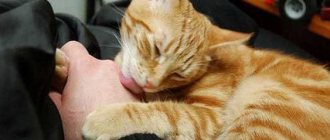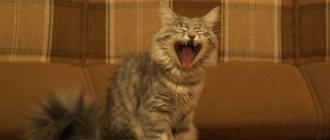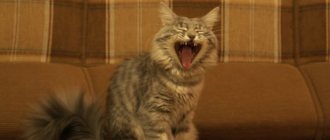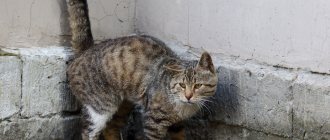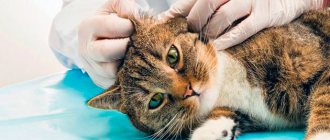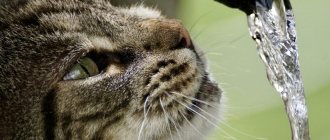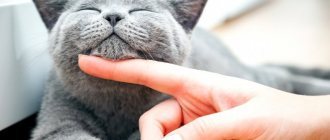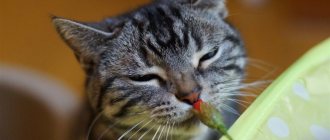Cats make swallowing movements several dozen times a day. This process begins to attract the attention of the owner when the animal swallows almost constantly, or this symptom is accompanied by other manifestations.
Swallowing is the voluntary process of moving saliva from the nose or food from the mouth into the pharynx and then into the esophagus. Swallowing food can be roughly divided into 3 stages (the first 2 of them can be performed consciously, the last only automatically):
- Preparation or oral phase. Food goes through a stage of salivation and chewing. Then it is fed onto the back of the tongue to move into the pharynx.
- Pharyngeal phase. This is the section of the food tract from the oral cavity to the esophagus. Passing through this area, food enters the esophagus.
- Esophageal phase. Food moves down the esophagus towards the stomach and enters the stomach.
Swallowing liquid or saliva occurs according to the same principle: saliva or water accumulates in the oral cavity, moves towards the pharynx, a swallowing movement is made and it enters the esophagus, and then into the stomach.
When do you need to see a veterinarian?
If your cat does not lick itself or, on the contrary, licks itself vigorously for several weeks or months, then you should consult a specialist. It is especially necessary to contact a veterinary clinic when the pet is lethargic and refuses water. Consultation with a veterinarian is necessary for hair loss and the appearance of bald patches. An allergic reaction that causes a cat to lick itself often can rarely be dealt with on its own. It is imperative to consult a specialist if you have nausea and vomiting, which may indicate impaired functioning of the kidneys, liver and urinary system. To make a diagnosis, the doctor will prescribe various procedures, based on the results of which further treatment is selected.
Symptomatic diet and procedures
Swallowing is often a completely harmless symptom. For example, if a cat is bothered by a lump of fur in its stomach, then it will swallow and lick itself until the lump comes out of it.
To prevent minor problems from developing into serious illnesses, you should carefully monitor what your cat eats, what she plays with, and what foods she may have an allergic reaction to.
It is necessary to remove from the area accessible to the cat all small objects that a curious beauty can taste.
To avoid allergic reactions, you should not prescribe medications yourself, much less treat your animal with medications for humans. All medical procedures must be carried out strictly after consultation with a specialist. By the way, allergies for cats are not as safe as they seem. Animals are also susceptible to attacks of suffocation and swelling of the ENT organs.
Do not forget that compulsive swallowing is one of the very first signs of problems in a cat’s body. Of course, you don’t need to run to the veterinary clinic for the slightest reason, but it is recommended to monitor your pet’s condition for 1-2 days.
A cat constantly licks itself - a natural reflex or a harbinger of illness
A cat may swallow frequently when vomiting, and vomiting itself may begin several hours after the start of frequent swallowing movements.
Infections
The cat may constantly swallow, make sounds similar to hiccups, and has a high fever. These signs are classified as infectious diseases of the animal. What kind of disease can only be found out from a veterinarian.
Foreign body
A cat may swallow frequently if its esophagus or stomach is clogged with fur, or if an object has become lodged in it. If your cat is choking on a fish bone or even several fish bones, she may swallow and try to push them down. Sometimes these actions are followed by gagging. If there are hairballs or rain, the cat may vomit them out.
When a needle is swallowed, if it remains in the oral cavity (for example, immersed in the tissues under the tongue), the animal’s body temperature may increase, regional lymph nodes may enlarge, the cat often swallows, and at the site of puncture by the needle (if it breaks and a fragment is stuck in the tissues) it may there may be inflammation and even necrosis.
Kidney pathology
With renal failure, the animal becomes apathetic, drinks a lot, refuses food, and its daily diuresis changes. At the same time, he may often swallow due to severe intoxication and nausea.
Stress relief
Cats often crumple a soft blanket or rug after they have been deprived or offended in some way. For example, they did not give a piece of sausage from the dinner table, although the animal begged for it with all its might. They woke you up or forced you to leave your favorite and already warm place. In this case, the pet often begins to intensively crush various interior items with its paws, however, it does not begin to purr.
Cats crush a person with their paws, splashing out negative emotions. The pet tries to improve his own mood. Often, after stomping around on the blanket for a while, the cat returns to its owner and lies down next to him - this is how the animal shows that it is no longer angry and is ready to continue friendly communication with the person.
The cat swallows often
Good afternoon Cat (Turkish Van) 1.3 years old, neutered at 7 months, completely domestic, no contact with the street over the last year, very hyperactive, living in Rostov-on-Don, food - Proplan with salmon for neutered dry, plus 3 times soft a week, raw chicken breast once a week, raw fish several times a month (he hasn’t eaten it for the last 3 months), constantly carries “non-cat” food from the refrigerator. A few days ago his voice changed, it became not so hoarse, but more Hoarse or something, the timbre has changed. two days ago there was an accidental contact on the staircase with a yard cat (she was sneezing, had green snot), he sniffed her and rubbed her (before that he had not seen other cats at all). And now two days later (and since yesterday he has not meows in general) as if he is trying to burp something, tilts his head low to the floor. But not intensely, silently, without drooling or wheezing, gently and once, at intervals of about once every 1-2 hours. It has been noticed that when scratching under the neck, the throat area, this spasm occurs, although not reliably, it practically leads to this. I haven’t pooped for more than a day. When you pick it up under the armpits, it makes a barely audible sound of “discontent,” as if grumbling and slightly extending its claws, i.e. makes it clear that there is discomfort; a wheezing sound is heard when breathing somewhere inside or something. He splashes and licks his lips all the time. And when swallowing, you can hear that it is difficult; a sound is made in the deep throat, as if a person is swallowing with his head thrown back. Prefers to lie near the battery. When palpating the abdomen, there were no pain reactions. I haven’t eaten anything that could get stuck in my throat this week. I had very little appetite yesterday. Today he doesn’t eat at all, sniffs, spits and turns away, doesn’t drink. He sleeps all the time, or sits with his paws tucked towards himself
The eyes are half-closed with the inner eyelid, sleepy. With sudden movements of the hand, he immediately pays attention, the eyes widen, he is interested, ready for a playful “attack,” but that’s where the matter ends
WHEN STROKING AND CAREFULLY IT DOESN'T PURL AT ALL, YET ONE TOUCH WAS ENOUGH!
There is no snot, eye or other discharge, the temperature in the evening of the 28th was 39.4, in the evening of the 29th - 38.7, on the 30th - at 1 am - 39.1. An injection of 0.5 cubes of Gamavit under the skin was given for prevention on the evening of the 29th.
I understand that there can be a huge number of reasons, I am a doctor myself, but at the moment we are in a place where there is no veterinary center, and we will be here for another week. Could he have contracted some kind of nasty disease from a barn cat? Although the timbre of the voice changed the day before contact with her... Is it appropriate to continue Gamavit? (once a day 0.5-0.7) Or is it a respirator? Then tell me some medications or antibiotics? (I tolerated amoxilav normally, I was injected once six months ago, my foot rotted) Then why are there problems with stool, before - every day.
Why might an animal bite while ironing?
Read also: Bad taste in mouth
It always looks very strange when you pet your pet, and he seems to purr, but suddenly bites you, trying to open the veins. In fact, this behavior does not mean at all that your pet is unhappy. He doesn't mind demonstrating his love, but at the same time he is categorically against you touching him now. There is also a possibility that you touched him or stroked him incorrectly.
Commonly known symptoms
One of the clearest criteria for a cat’s health is its fur. If the cat's fur is smooth and shiny, there is no dandruff, and the cat does not itch constantly, then this is evidence of health. Your nose will tell you about your temperature.
The normal temperature of an adult cat is 38-39 degrees, for a kitten it is above 39.5 degrees.
A moist and cool nose indicates that the temperature is normal. A dry nose indicates an elevated temperature. In this case, the cat often licks its lips.
A low temperature is more dangerous than an elevated temperature and indicates that the cat’s immune system is weakened and the body is poorly resistant to the disease.
If a cat's eyes become large and the pupils are not visible, then this is a clear symptom that the cat is in pain and is clearly unwell. A cat's breathing at rest is always smooth and inaudible. If your cat's mouth is open and breathing is rapid and noisy, it means your cat has health problems. It could be a heart attack or stroke, or it could be heatstroke.
Visible symptoms of the painful condition include various types of discharge from the eyes, nose, as well as a pale, blue tongue. Obvious symptoms of cat diseases include vomiting, constipation and diarrhea. This is a clear signal of the possible development of a serious internal pathology in the animal, requiring immediate examination.
- Symptoms of cat diseases
- Symptoms of cat diseases
- Symptoms of cat diseases
Vaccination prevents infection from certain infectious diseases. A cat may develop diseases that other mammals suffer from: diabetes, cancer, asthma, kidney disease.
The benefits of purring
There is a theory that purring can cause cats to produce a hormone that helps strengthen and grow bone tissue. Since most of the time the animal is passive, it needs restoration of the musculoskeletal system.
Cat purrs calm and relax people, helping relieve stress and lower blood pressure. The sound of purring is at a frequency of 20 to 44 Hz. It is capable of starting healing processes in humans, similar to ultrasound treatment.
One theory says that cats are able to treat gastritis, colitis and other gastrointestinal diseases in their owners with their purring.
Reference! Cat owners are less likely to have a heart attack.
Causes
The following factors influence the frequency of licking:
- Unbalanced diet.
- Hormonal changes.
- Wounds.
- Urogenital diseases.
- Allergy.
- Stress.
- Ectoparasites.
Licking is a natural process
Unbalanced diet
A domestic cat's coat changes twice a year. This is a natural process that slows down when there is an imbalance of nutrients. Cheap natural food and ready-made economy-class feeds do not have enough amino acids and vitamins for the formation of hairs. Uncontrolled use of food additives only aggravates the problem. Hypervitaminosis is more dangerous to health than a lack of biological catalysts. When using premium food, there are no delays in shedding.
Hormonal changes
A cat is a neat animal, so it eliminates the consequences of hormonal surges. Excessive licking of the genitals is observed during estrus, gestation, and lactation. This phenomenon is temporary; upon transition to a state of rest, the frequency of licking is normalized.
During the aging process, the production of hormones is disrupted, which affects the condition of the coat and skin. The cat is self-medicating.
Licking genitals
Wounds
Damage resulting from injuries, as well as post-operative sutures, itch. Therefore, the animal cleans them by licking. Sometimes protection from cat actions is required. In such a situation, the animal is given a sedative and an Elizabethan collar is placed around its neck.
Urogenital diseases
After giving birth, the female licks her vulva. Often a habit masks the onset of a disease. When endometritis begins, the cat removes scanty vaginal discharge with its tongue, which makes it difficult to notice the inflammation in time. Therefore, the very fact of increased licking should alert the responsible felinologist.
Allergy
Hypersensitivity occurs to certain irritants:
- flea saliva;
- dust, perfumes, detergents;
- accessories;
- feed components.
Allergens cause itching, scratching, baldness, rashes, and blisters that the cat scratches and licks.
Licked himself
Stress
The animal is nervous, trying to calm down, and begins to tidy up its fur coat. It is necessary to pay attention to the accompanying symptoms - marking the territory in the corners, tearing up upholstered furniture with claws, refusing the usual food and begging.
Ectoparasites
Flea bites are very annoying for your cat. Active licking aims to stop pruritis and catch insects. Some animals become allergic to flea bites.
What is a “milk step” and where does it come from?
Fingering with the front paws, accompanied by purring, is most often associated with childhood memories. It is called the "milk step". Kittens use this kind of massage to knead their mother’s mammary glands. It stimulates milk production and allows the baby to eat heavily.
Read also: Why you can’t cut fungal nails?
The feeling of satiety and security “under the wing” of a mother cat brings very pleasant emotions, so many animals retain this habit even into adulthood.
The most common diseases in cats:
Asthma Chronic renal failure Cancer Diabetes Leukemia Urolithiasis Liver amyloidosis Hyperthyroidism Immunodeficiency virus Hepatic lipidosis Infectious peritonitis Hypertrophic cardiomyopathy Ringworm Liver diseases
Before you take your cat home, you should make sure it is healthy. Every year your cat needs a veterinary examination. The earlier you detect a disease, the easier it is to treat.
There are diseases that can be transmitted from cats to humans, but this does not happen often. These diseases are: Cat scratch fever Rabies Ringworm Toxoplasmosis
If your cat has the following symptoms, this means that the pet is sick: the cat lies with its paws tucked in for a long time; lethargy (accompanies almost all diseases in cats); the cat’s body is hot (probably fever); poor appetite or refusal to eat; loss of body weight, even if The cat has a normal appetite The cat drinks much more than usual Very frequent or large amounts of urination Straining when urinating (take the cat to the vet immediately) Persistent sneezing Hoarseness, choking or difficulty breathing The cat is coughing, gagging diarrhea or blood in the stool vomiting convulsions, seizures , trembling, twitching and disorientation, the animal is bleeding, in addition to scratches, a bump or swelling, the animal is swaying, limping.
Skin diseases that are easiest to diagnose are the purr. The most common types are wet and dry eczema, tangles, and trichomes. If your cat is covered in red spots, itches all the time and has hair falling out, it most likely has dry eczema. But wet eczema is characterized by the appearance of weeping red spots, and this disease occurs due to allergies. Matted hair or tangles, this disease is typical mainly for long-haired cat breeds.
Common infectious diseases in cats are colds, sore throat, and bronchitis. The symptoms of these diseases in cats are very similar to those in humans. The disease is accompanied by a runny nose, cough, indigestion and fever. For example, bronchitis usually affects weakened and old animals. Bronchitis is an inflammation of the lining of the bronchi in cats, and can be acute or chronic. For effective treatment, first of all, you need to provide the animal with good nutrition and a warm place, because feline bronchitis occurs with the same symptoms as in humans (chills, increased body temperature, fever). For treatment, you need to use expectorants and disinfectants, medications that dilate the bronchi, antibiotics, antimicrobial agents, and inhalations.
- Symptoms of cat diseases
Symptoms of cat diseases- Symptoms of cat diseases
Therapeutic effects on humans
According to professional breeders, pets are capable of healing. This theory is partly true. It has been scientifically proven that they can help a person.
Treatment with cats or feline therapy is a therapeutic technique that anyone can resort to if they are not allergic to wool. Cats are able to sense the owner’s mood; if treated gently, he will come to the rescue when you need to relieve tension.
In addition to the fact that cats help you feel better, their purring calms the human nervous system.
However, rumbling has another function - thickening the bones. Pets use it to heal fractures, since the frequency of sound vibrations from 20 to 50 Hz has a positive effect on bone tissue.
Doctors recommend communication with cats for people diagnosed with schizophrenia, cerebral palsy, and autism. Regular communication will help in socialization of children, becoming a good friend. The care shown by pets normalizes the human condition.
Read also: Why cacti have become soft
Common diseases
The most common diseases in porridge are parasitic. Timely prevention is the best treatment for these diseases. In any pet store or veterinary pharmacy you can find many different anthelmintic drugs. In the end, you should always remember about skin parasites: fleas, ticks, lice eaters. It is enough to simply treat the cat with insecticidal shampoo in the same way as written in the instructions. Another option is to rub an antiparasitic agent into the skin, in the area of the withers, of which there are many in veterinary pharmacies.
Another disease that a cat can get is otitis media (inflammation of the middle ear). This disease brings unbearable pain to your pet. The main cause of this disease is drafts, plus microorganisms such as streptococcus and staphylococcus.
Common symptoms of this disease are: loss or significant decrease in appetite, ear pain, fever, apathy, and sometimes vomiting.
For treatment, it is necessary to take a course of antibiotics. And, also, it is necessary to regularly wash the cat’s ears with hydrogen peroxide (3% solution), then you need to drip 2 drops of iodoform ether inside. And of course, be sure to take painkillers.
Cats are very susceptible to a disease such as purulent conjunctivitis; it is most often caused by pyogenic microorganisms. The main symptom of the disease is the appearance of a characteristic purulent sac on the animal’s eye. When treating this disease, it is imperative to use intramuscular antibiotics. Also, you need to regularly and methodically wash your cat’s eyes with a weak solution of furatsilin, and be sure to apply ointments such as tetracycline, oletethrin, erythromycin to the conjunctival sac every day. If necessary, give sulfonamide drugs orally.
Infectious diseases of cats and dogs
Why does my cat constantly lick his lips?
What does claw extension mean?
While performing the “milk step,” the animal’s body relaxes and the function of retracting and extending its claws is involuntarily triggered.
While trampling, a cat may release its claws, involuntarily injuring a person. But you shouldn’t be offended by this impulse of your pet. This is another manifestation of cat love.
The movement of the paws promotes the release of secretion from the back of the paws, which is rubbed into the fabric and other surfaces. Therefore, your pet may scratch your arms or legs (mark it as property).
Treatment options
A necessary criterion for determining excessive drooling is passing all the tests prescribed by the doctor. If this is feces and blood, then with their help you can find out about the presence of helminths in the animal. If you donate urine, the results will show possible changes in the pet’s genitourinary system.
After completing all the necessary tests and other procedures, the veterinarian will be able to find the cause of excessive salivation. In addition, he will make an accurate diagnosis and give recommendations regarding treatment. And it will contribute to the cat’s recovery and at the same time increase the function of the salivary glands.
When a doctor discovers injuries or wounds in an animal’s mouth, he prescribes certain drops and ointments. The first product should be dripped onto the cat's tongue, and the second should be lubricated on the throat and inside of the mouth. This is necessary for the healing of wounds and the recovery of the pet.
In more serious cases, a full diagnosis is necessary. It will help determine the causes of excessive salivation, the extent of the disease and possible methods of treating it. In some cases, hospitalization may be required.
Signs of increased salivation
Having a cat in the house, many do not think about its possible drooling.
But when faced with this problem, the owner begins to look for how to deal with it. Therefore, you need to know in advance the causes of drooling in cats in order to prevent a similar disease in your pet in time. And then the animal will be able to thank you with its surprisingly good mood. Saliva protects the mucous membrane of the mouth, participates in the breakdown of food and thermoregulation. The process of its formation is called salivation, increased secretion is called hypersalivation or ptyalism.
The norm is considered to be short-term wetness of the fur along the edge of the mouth; the following external signs indicate excess saliva:
- chin and neck get wet;
- tongue falls out;
- stains form on the bed;
- icicles hang from the mouth, on the chest;
- the cat swallows more often;
- constantly washes his face;
- rubs his cheeks against the corners of the furniture.
The face, neck and chest look sloppy, even if the cat constantly licks itself and washes itself.
The most purring breeds
There is no exact data on which cats purr louder and more often than others. It depends on the character and individual characteristics of the four-legged animal. But, since purring is one of the means of communication for cats, it can be assumed that sociable cats purr more often. The most affectionate cat breeds:
- Exotic
- Burmese
- Sphinx
- Burmanskaya
- Scottish lop-eared
- Manx
- Ragdoll
- British Shorthair
- Maine Coon
- Siamese
Whether a cat will purr and caress depends not so much on the breed, but on the attitude of the owner. A kind and affectionate pet will grow up in a loving, caring family.
Reference! The British cat Merlin entered the Guinness Book of Records for the loudest purr at 67.8 dB.
Cats purr in different sounds, depending on the reasons. If you listen to your pet, you can learn to understand him much better. This will not only make the cat happier, but also strengthen the bond between the animal and its owner.
Purrs, smacking: The veterinarian explained why cats “suck” the blanket
How to help a kitten cope with the stress of being separated from its mother
Little kittens are unable to cope with their fears on their own. When a kitten is separated from its mother cat, the babies become vulnerable. Therefore, their future life depends on the care and affection of the owner. The most important reflex is sucking. Separation from mom becomes a test. The kitten begins to “suck” the tissues: soft and saturated with the smell of the owner. The veterinarian explained why this happens and how to help the pet.
Cats have their own quirks. But in order to understand the reasons for strange behavior in time, it is important not to miss the moment. From childhood, children experience stress after entering adulthood without their mother. From this moment on, they completely rely on their owner. Therefore, the lack of mother’s warmth is expressed in “sucking.” Blankets, rugs, sheets and robes - all this attracts kittens.
At the moment when the kitten begins to purr and grab a blanket or clothes with its mouth, you need to pick it up. Be sure to stroke the head and nose. Quietly pronounce his name and do not let go until the baby stops purring. In a few days, in this way you can wean your cat off the pronounced reflex.
The veterinarian calls this behavior a “need” that should be eliminated. Whether it's a kitten or an adult cat, licking fabric with a rough tongue is harmful. The particles enter the stomach and remain there. The solution to the problem lies in sufficient and timely attention to your pet.
Source
Consequences of self-medication
At home it is impossible to identify the cause of ptyalism, and without an accurate diagnosis it is impossible to cope with the underlying disease.
Losing time can lead to complications, including the death of your pet:
- Rabies cannot be treated; if infection is suspected, the cat is isolated and changes in health are monitored. If this is not done on time, the virus is transmitted to others through the bites of a sick animal. A person can only be saved by a course of injections of an anti-rabies vaccine to produce antibodies to the virus. Delay with injections leads to death.
- For calcivirus infection, a complex of drugs will be required. The disease goes away in 7–10 days if it is diagnosed in time and treatment is started. In the advanced stage, secondary infections occur and pneumonia develops.
- When an object gets into the throat, the pet's larynx suffocates. They urgently take the cat to the clinic and do not try to remove it themselves. A foreign body in the stomach or intestines causes tissue necrosis, mucosal ruptures, and obstruction. It is detected using x-rays or ultrasound and can only be removed surgically.
- Severe forms of chemical burns cause toxic shock and impair respiratory function. Without emergency assistance, suffocation occurs and the animal dies.
- Inflammatory diseases of the gastrointestinal tract do not go away without medications and a therapeutic diet; they exhaust the cat and shorten its life. Drugs are prescribed only after identifying the cause of inflammation and making a diagnosis.
- Gingivitis and stomatitis without proper treatment become chronic, when inflammation begins from the slightest irritant and is not completely cured. The animal experiences constant pain, and because of this, its character deteriorates. With chronic gingivitis, diseased teeth have to be removed.
- When poisoned, a cat loses fluid, and in severe cases, dehydration occurs. Due to the wrong choice of medications, intoxication increases, the gastric mucosa becomes inflamed, bleeding begins, and toxins affect internal organs.
Increased salivary secretion in cats cannot be considered a harmless symptom. This phenomenon accompanies a lot of pathologies that cannot be dealt with without medical help.

